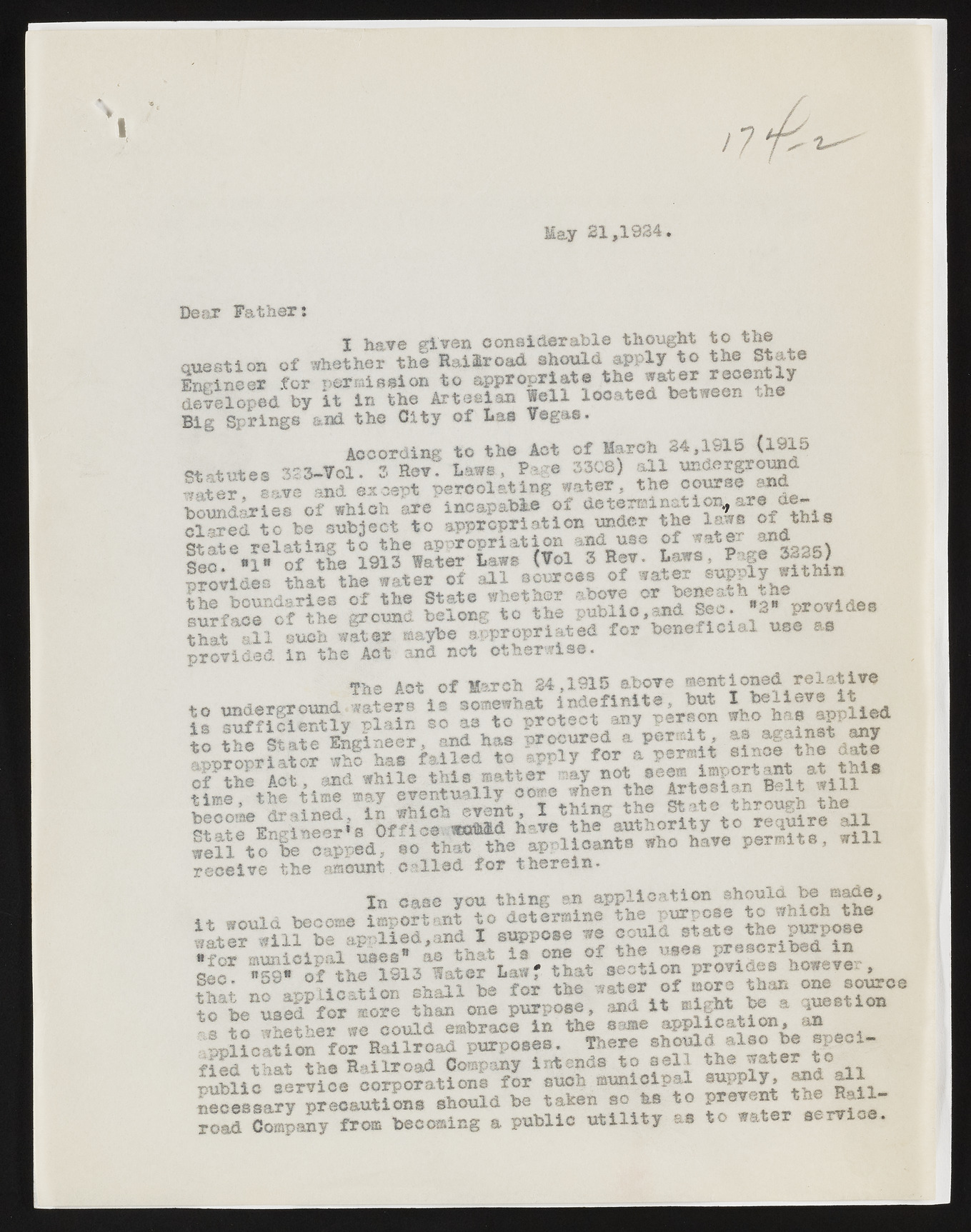Copyright & Fair-use Agreement
UNLV Special Collections provides copies of materials to facilitate private study, scholarship, or research. Material not in the public domain may be used according to fair use of copyrighted materials as defined by copyright law. Please cite us.
Please note that UNLV may not own the copyright to these materials and cannot provide permission to publish or distribute materials when UNLV is not the copyright holder. The user is solely responsible for determining the copyright status of materials and obtaining permission to use material from the copyright holder and for determining whether any permissions relating to any other rights are necessary for the intended use, and for obtaining all required permissions beyond that allowed by fair use.
Read more about our reproduction and use policy.
I agree.Information
Digital ID
Permalink
Details
Member of
More Info
Rights
Digital Provenance
Publisher
Transcription
May 21,1934. Dear F ath er: I have given con siderable thought to th© Question o f whether th e R a ilro a d should apply t o the S tate Engineer fo r normissi on to appropriate the water r e c e n tly developed by i t in the A rtesian f e l l lo c a ted between the B ig Springs and the C ity o f has fega® . According to the Act o f March 24,1915 (1915 Statu tes 323-Tol. 3 Rev. Daws, Page 3308) a l l underground w ater, save and except p e rc o la tin g water, th e course and boundaries o f which are incapable o f deterr^na-ion^ are dec i d e d t o be subject to appropriation under the laws o f th is State r e la tin g to th e appropriation and use o f * * * * * <?ac »X« o f the 1913 la t e r haws (F o l 3 Rev. Laws, Fag# £ ???' provides that the water o f a l l sources o f »d ts r s u p p ly *ith in the boundaries o f th e State whether provides surface o f the ground belong to the pub±i©,«*ad S©^* W that a l l such water Maybe appropriated fo r b e n e fic ia l use as provided in the Act and not otherw ise. th e Act o f March 34,1915 above mentioned r e la t iv e underground waters i s somewhat in d e fin it e , bu« I b eliw ve i t I s S i f i S S r t l y “ la in so as to p ro te c t any person who hns a jP M w i U t t r s f a t f l ^ B i n e e r anddhn. 3 3 Pt £ f Act a5S°wMl® t h i s natter'm ay not s e s m import ant at th is ? L f # i t S may even tu a lly o « e when the A r t e s i a n ^ w ill become drained, in Whic** e v e n t, ^ otate Engineer’ s Offic©..wafcld hav e ththine g authority t. o rreeoquuiirree aaxlXx w e ll t o S capped, so that the applicants who have perm its, w ill re c e iv e th e aaomst. c a lle d fo r th e re in . In case you th in g m a p p lic a tio n should be made, i t would b e c o m e important t o determine m « / S l J S water w i l l be applied,and I suppose * « oould s ta te the purpose * fo r municipal uses’* as that is one o f the usee p resen ce© in sec. Bogu9 * v0fz hthueo a1v91* 3 later Law?> that sectio0nf rparoerGv iat©h#an aoownee vseo, u, rce that no application sh all be for tne was©* ui u * nation to be used for more than one purpose, and i t »*g$t J* j& to whether we could embrace in the name application* a® R i o S * t e W l m i purposes, there « M M ?**> * » th at th© R a ilro a d Company intends to s e l l th e water to J i b l i l s L v i L c o r p o S t i o S fo r such municipal supply, and a l l n e c e a s a rfp re ca u tlo n s should be taken so hs t o prevent the R a ilroad Company from becoming a pu b lic u t i l i t y as t o water s e rr io e .

